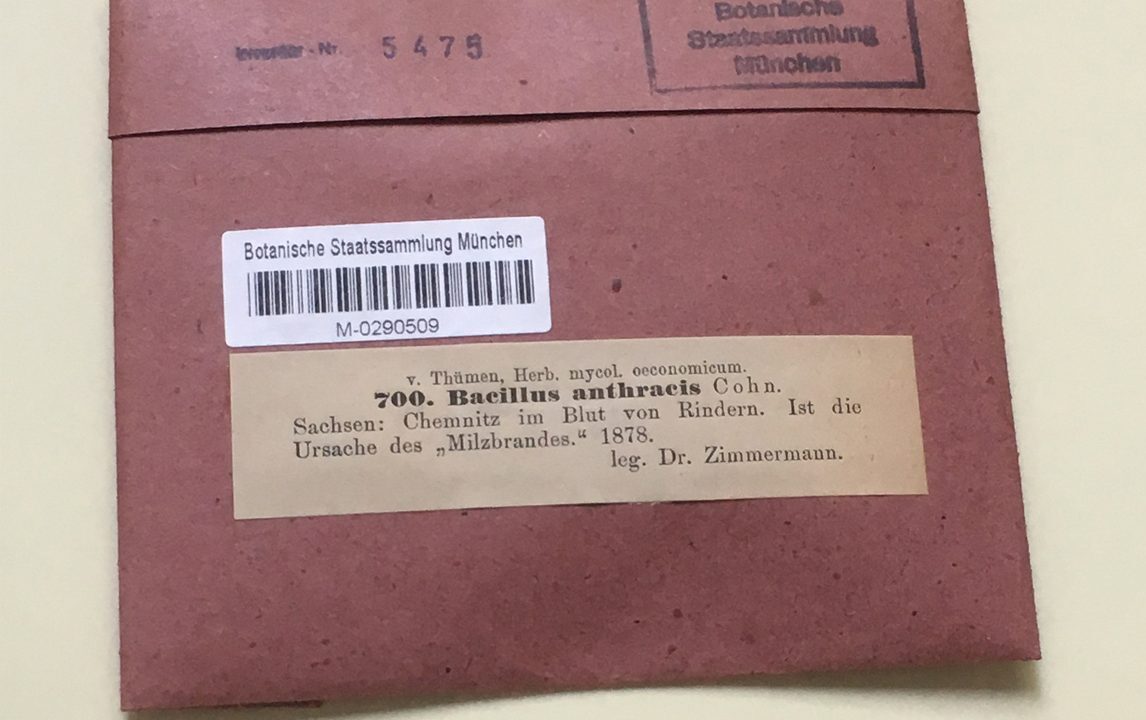A rare glimpse into the past of the anthrax pathogen Bacillus anthracis
During an inventory, a scientist at the Bavarian State Collection of Botany (SNSB-BSM) made a surprising discovery: a 142-year-old slide containing a blood sample that came from a cow infected with the anthrax pathogen Bacillus anthracis. Scientists at the Bundeswehr Institute of Microbiology (IMB) were able to decode the oldest documented genome of B. anthracis from this sample. They recently published their results in the microbiological journal “Microorganisms”.
Unlike other pathogens such as Yersinia pestis (plague) or Mycobacterium tuberculosis (tuberculosis), little is known about the historical genetic evolution and geographical distribution of the anthrax pathogen. Dr. Dagmar Triebel, curator of Fungi and Algae at the Bavarian State Collection of Botany (SNSB-BSM), was all the more surprised when she came across a collection envelope labeled “Bacillus anthracis, Chemnitz, 1878″ during an inventory in the Fungi collection. The envelope contained a historical slide on which a drop of blood from a Saxon cattle infected with the anthrax pathogen had presumably been applied and dried up. The blood sample thus dates from approximately the same period in which the German physician and microbiologist Robert Koch succeeded in uncovering the bacterium’s life cycle in his pioneering studies (1876).
Unsure how to handle the sample, which might still be infectious, the mycologist turned to scientists at the Bundeswehr Institute of Microbiology (IMB). The head of the anthrax specialist laboratory at the IMB, Dr. Gregor Grass, gave the all-clear: “The material, which is over 140 years old, has long been inactive and is therefore harmless. But this historic bacterium is a valuable resource for reconstructing the past genetic evolutionary history and historical spread of the anthrax pathogen. If confirmed, the specimen discovered here could be the oldest documented B. anthracis specimen known to date.”
In the laboratory, this assumption was then actually confirmed. The genome of the historical B. anthracis was successfully decoded from the biologically inactive material. The team of microbiologists achieved this by using a specially adapted isolation method that provided the genetic material (DNA) of the pathogen. “We were surprised by the quality and quantity of DNA recovered in this ancient sample.” From the sample, the scientists were able to clarify the genetic relationship of the dead bacterium under study: Its closest relative from modern-day samples comes from near Stuttgart. “The study once again shows the importance of natural science collections as a historical source for current research questions, especially in times when questions of research into diseases and epidemics are gaining in importance,” emphasizes Dr. Dagmar Triebel.
Publication:
Braun, P, Knüpfer, M, Antwerpen, M, Triebel, D & Grass, G 2020. A Rare Glimpse into the Past of the Anthrax Pathogen Bacillus anthracis. Microorganisms 2020, 8(2), 298. [1-7].
https://www.mdpi.com/2076-2607/8/2/298
Contact:
Dr. Dagmar Triebel
SNSB Botanische Staatssammlung München
Menzinger Straße 67
80638 München
Tel.: 089 178 61-252
E-mail: triebel@snsb.de
PD Dr. Gregor Grass
Institut für Mikrobiologie der Bundeswehr
Abt. Bakteriologie und Toxinologie
Neuherbergstr.11
80937 München
Tel.: 089 99 26 92 39 81
E-Mail: GregorGrass@bundeswehr.org



